 Rave
reviews for Ray Carney’s pioneering American Dreaming:
The
Films of John Cassavetes and the American
Experience (Berkeley,
California: University of California Press, 1985), the first
book ever written about Cassavetes’ life and work, in
any language. It has long been out of print but is now newly
available
through
this web site for $20 in a Xerox of the original edition. You
may order over the internet with a credit card through PayPal
or through
the mail with a money order. See below. Rave
reviews for Ray Carney’s pioneering American Dreaming:
The
Films of John Cassavetes and the American
Experience (Berkeley,
California: University of California Press, 1985), the first
book ever written about Cassavetes’ life and work, in
any language. It has long been out of print but is now newly
available
through
this web site for $20 in a Xerox of the original edition. You
may order over the internet with a credit card through PayPal
or through
the mail with a money order. See below.
Click
here for best printing of text
| Kathryn
Jankowski, The San Francisco Chronicle Sunday Review,
June 23, 1985 |
Complex
Portrait of an Iconoclast
“American
Dreaming is an intense and intriguing exploration
of the films of John Cassavetes, whom author Raymond Carney heralds
as “America’s greatest, yet most astonishingly neglected
and misunderstood, filmmaker.
“According to Carney, no one has ever undertaken a study
of Cassavetes’ work before, because the actor–director’s
films neither look nor feel like other movies. In order to appreciate
the man, says Carney, we must free ourselves from ‘prefabricated
structures and codes of understanding, including, but not limited
to, the systems of meaning most critics look for and describe in
works of art.’
“To support his
contention that Cassavetes' experiments with these ‘systems
of meaning’ – pacing, photography,
narrative, theme – are underrated by critics and audiences
alike, Carney painstakingly analyzes how and way Cassavetes’ chronicles....
are unjustly deemed inferior by an artistic establishment enraptured
by metaphorical and philosophical films.
“Carney argues
persuasively for the supremacy of what he asserts is the theme – ‘characters
in invigorating transit between authentic life and stultifying,
prefabricated, predetermined styles of expression.’ He
bolsters his arguments with trenchant examples from Cassavetes’ oeuvres,
and parallels intelligently Cassavetes’ personal fight
for individuality in a movie–making bureaucracy with his
cinematic middle-class characters’ struggle to achieve
love and integrity in an environment hostile to both.
“Carney discusses what he considers to be important influences
in Cassavetes’ life, among them an idealistic Greek father
who immigrated to America at the age of 12, his training as a ‘method’ actor,
documentary filmmakers Shirley Clarke, Morris Engel, and Lionel
Rogosin, New York’s avant-garde film community, the
Italian neorealists and, of course, Hollywood.
“The author also succeeds in finding analogies with other
artists he claims share Cassavetes’ avoidance of stylistic
and rhetorical patterns, such as writers Frost, Bishop, and Welty,
and choreographer George Balanchine. Moreover, Carney establishes
Cassavetes convincingly as a filmmaker in the populist tradition
of Capra and Chaplin.
“What emerges
is a complex portrait of an iconoclast who acts in studio productions
primarily to finance his own independent
films, a man Carney sums up as ‘our noblest, most inspiring,
and truest historian of the American experience.’ While one
may dispute that assessment, American Dreaming does spark
a desire to review Cassavetes’ films, and therein lies one
of the biggest frustrations of the book. With the exception of Gloria,
available on videocassette, the films discussed are rarely screened.” [RC:
The sad state of affairs in 1985 when I wrote this book, only slightly
better today.]
|
| The
Film Review, Longwood, England, 1986 |
[Just
for laughs, I have included the editor’s addition to the
reviewer’s text when it appeared in print. The contention
that Cassavetes was a major filmmaker was considered utterly preposterous
at the point the book was published.]
“A study in depth of the films of John Cassavetes. Known mainly
to the general cinemagoer for his acting roles in Rosemary’s
Baby,
The Dirty Dozen, The Fury, and others, Cassavetes'
real interest has lain in the making of a series of highly personal
and original films,
tracing with subtlety and insight the complications of human relationships.
That he is ‘America’s greatest film–maker’ may
be open to argument [It most certainly is! — Editor], but that
he has been ‘astonishingly neglected and misunderstood’ is
probably true. This detailed, enthusiastic, and well–written
book should go far to widen interest in his work. There is an excellent
filmography.” |
| Cinema
Notes and Reviews, December 11, 1986 |
| “This
study is – in its peculiarly intelligent way – almost
as passionate and erratic as some of the movies it discusses. Carney’s
book begins the long overdue full assessment of an extraordinary
director’s achievement. It also calls into question a wide range
of commonly held assumptions about ‘well–made’ films,
and on these bases alone it is one of the half–decade’s
most important critical studies on American film.” |
| Lucio
Benedetto, PostScript Magazine, Winter 1992 |
| "By
far the most thorough, ambitious, and far-reaching criticism of
Cassavetes'
work has been accomplished by Raymond Carney, currently Professor
of Film and American Studies at Boston University. Carney wrote
the first book-length study of Cassavetes, who languished in critical
obscurity until the publication of Carney's American Dreaming in
1985.... In Carney's view, to settle the accounts of our lives,
to decide once and for all, is, for Cassavetes, to tumble headlong
into the abyss of nonentity upon which we incessantly verge. Carney
argues that Cassavetes has re-invented the craft of filmmaking
in ways that drastically alter our casual habits of film viewing.
To adapt William James' terminology (which Carney is indebted to)
Cassavetes' works are concerned less with the events and finished
episodes that make up the 'substantive' parts of our
experience and more with the moments of insecurity, the 'transitive' slippages
during which our habitual strategies for understanding and stabilizing
our relationships with ourselves and others cease to function in
any useful way.... Carney's work with Cassavetes, placed within
the context of his later book, American Vision, on Frank Capra,
can be viewed as an attempt not only to further the understanding
of American film, but to forge a new synthesis of understanding
in American Studies, making his critical works valuable not only
to film scholars, but to students of American culture generally." |
| Inspired
by this book, composer Marc Couroux borrowed its title for
one of his compositions, Couroux's American Dreaming John Cassavetes
(Quelques Monuments de la Rue Ste-Catherine).
A statement by Couroux about his work follows, along with two passages
drawn from another book by Ray Carney, The Films of John
Cassavetes: Pragmatism, Modernism, and the Movies, that inspired him especially
when he composed the music:
|
| American
Dreaming is named after the book by Raymond Carney on filmmaker
John Cassavetes (1929-1989), the very first study of this revolutionary
artist. I first came to Cassavetes through his film Husbands, which
was unlike anything I had ever seen...all the cracks and fissures
and unpredictabilities of human experience were present. But also,
he always seemed to find a way to make clear that we are capable
of extreme flights of fantasy, of breaking out of the sedentary,
stiff existence his characters ordinarily lead. The weird non-linear
behavior of his characters is something we are all innately capable
of yet rarely access. In my music, the prevalent jumble occasionally
takes eccentric turns to the intelligible (at least seemingly),
a kind of fake quantization, where for a few minutes the rhythm
becomes traditionally aligned though the remaining elements of
the discourse (including general bodily comportment) are exactly
as they were. A sort of extremely unfathomable, unlikely, false "arrival".
I try to allow for these things to come into play when there is
a suitable crack in the material or some fortuitous intuition.
Raymond Carney in The
Films of John Cassavetes - Pragmatism, Modernism, and the
Movies:
"In Cassavetes'
work, rather than cumulating, succeeding meanings are orchestrated
so as to erase or war with preceding ones. Rather
than adding up, the jump-cuts in Minnie and Moskowitz hack each
preceding understanding to pieces. Meaning is proliferated away
from all static or unifying centers of significance...One of the
generating events in each film is for the central character to
have the rug pulled out from under him or her early in the narrative---so
that the character is suddenly forced to reevaluate all of the
fictions that organized life up to that point...."
"Cassavetes offers
us 'concatenated knowing' in place
of 'consolidated knowing'. Rather than rushing TO a
portable meaning, the viewer is forced to live THROUGH a changing
course of events. In this view of it, meaning is always in transition:
it lives in endless, energetic substitutions of one interest and
focus for another, in continuous shifts of tone, in fluxional slides
of relationship." |
Other writing by Ray Carney about John Cassavetes' life
and work
Ray Carney, Cassavetes
on Cassavetes (Faber and Faber in London, and Farrar, Straus
and Giroux in New York), copiously illustrated, paperback, approximately
550 pages. Available directly from the author for $25.
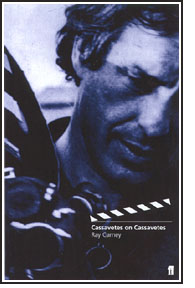 Cassavetes
on Cassavetes is the autobiography John Cassavetes never lived to
write. It tells an extraordinary saga – thirty years of film history, chronicling
the rise of the American independent movement – as it was lived by
one of its pioneers and one of the most important artists in
the history of the medium. The struggles, the triumphs, the crazy dreams
and frustrations are all here, told in Cassavetes' own words. Cassavetes
on Cassavetes tells the day-by-day story of the making of some of
the greatest and most original works of American film. —from the "Introduction:
John Cassavetes in His Own Words" Cassavetes
on Cassavetes is the autobiography John Cassavetes never lived to
write. It tells an extraordinary saga – thirty years of film history, chronicling
the rise of the American independent movement – as it was lived by
one of its pioneers and one of the most important artists in
the history of the medium. The struggles, the triumphs, the crazy dreams
and frustrations are all here, told in Cassavetes' own words. Cassavetes
on Cassavetes tells the day-by-day story of the making of some of
the greatest and most original works of American film. —from the "Introduction:
John Cassavetes in His Own Words"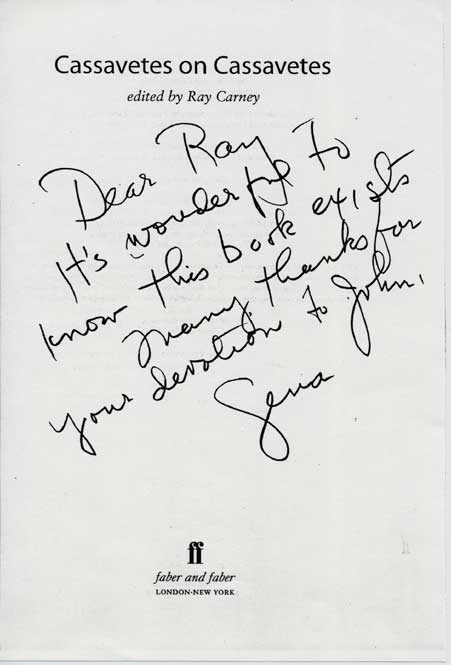
Click
here to access a detailed description of the book and a summary
of the topics covered in it.
* * *
Cassavetes on Cassavetes is
available in the United States through Amazon and Barnes
and Noble, and in England through Amazon (UK), Faber
and Faber (UK). It is also available at your local bookseller,
or, for a limited time, directly from the author (in discounted, specially
autographed editions) for $25 via this web site. See
below for information how to order this book directly from this web
site by money order, check, or credit card (using PayPal).
* * *
Ray Carney, The Films
of John Cassavetes: Pragmatism, Modernism, and the Movies
(New York and Cambridge: Cambridge University Press, 1994), 48 illustrations,
paperback, 322 pages. This book is available directly from the author for $20.
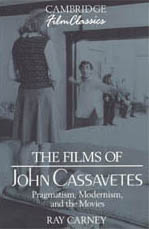
The Films of John Cassavetes tells the inside story of the making
of six of Cassavetes' most important works: Shadows, Faces, Minnie
and Moskowitz, A Woman under the Influence, The Killing
of a Chinese Bookie, and Love Streams.
With the help of almost fifty
previously unpublished photographs from the private collections of
Sam Shaw and Larry Shaw, and excerpts from interviews with the filmmaker
and many of his closest friends, the reader is taken behind the scenes
to watch the maverick independent at work: writing his scripts, rehearsing
his actors, blocking their movements, shooting his scenes, and editing
them. Through words and pictures, Cassavetes is shown to have been
a deeply thoughtful and self-aware artist and a profound commentator.
This iconoclastic, interdisciplinary
study challenges many accepted notions in film history and aesthetics.
 Ray
Carney argues that Cassavetes' films participate in a previously unrecognized
form of pragmatic American modernism that, in its ebullient affirmation
of life, not only goes against the world-weariness and despair of many
twentieth-century works of art, but also places his works at odds with
the assumptions and methods of most contemporary film criticism. Ray
Carney argues that Cassavetes' films participate in a previously unrecognized
form of pragmatic American modernism that, in its ebullient affirmation
of life, not only goes against the world-weariness and despair of many
twentieth-century works of art, but also places his works at odds with
the assumptions and methods of most contemporary film criticism.
Cassavetes' films are provocatively
linked to the philosophical writing of Ralph Waldo Emerson, William
James, and John Dewy, both as an illustration of the artistic consequences
of a pragmatic aesthetic and as an example of the challenges and rewards
of a life lived pragmatically. Cassavetes' work is shown to reveal
stimulating new ways of knowing, feeling, and being in the world.
This book is available through Amazon, Barnes
and Noble, your local bookseller, or, for a limited time, directly from
the author (in discounted, specially autographed editions). See
below for information how to order this book directly from the author by money
order, check, or credit card.
Clicking on the above links
will open a new window in your browser. You may return to this page
by closing that window or by clicking on the window for this page again.
* * *
For reviews and critical responses
to The Films of John Cassavetes, please click
here. (Use your back button to return.)
* * *
Ray Carney, John Cassavetes:
The Adventure of Insecurity
(Boston: Company C Publishing, 1999), 25 illustrations, paperback, 68 pages.
This book is available directly from the author for $15.
 |
-
New
essays on all of the major films, including Shadows, Faces, Husbands, Minnie
and Moskowitz, A Woman Under the Influence, The
Killing of a Chinese Bookie, Opening Night, and Love
Streams
-
New,
previously unknown information about Cassavetes' life and
working methods
-
A
new, previously unpublished interview with Ray Carney about
Cassavetes the person
-
Statements
about life and art by Cassavetes
-
Handsomely
illustrated with more than two dozen behind-the-scenes photographs
Click
here to access a detailed description of the book.
|
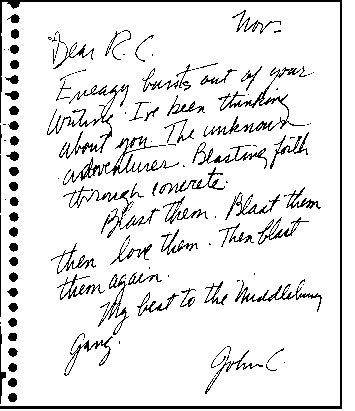 This
book is available through Amazon, Barnes
and Noble, your local bookseller, or, for a limited time, directly
from the author (in discounted, specially autographed editions). See
below for information how to order this book directly from the author
by money order, check, or credit card. This
book is available through Amazon, Barnes
and Noble, your local bookseller, or, for a limited time, directly
from the author (in discounted, specially autographed editions). See
below for information how to order this book directly from the author
by money order, check, or credit card.
Clicking on the above links
will open a new window in your browser. You may return to this page
by closing that window or by clicking on the window for this page again.
* * *
Ray Carney, Shadows (BFI
Film Classics, ISBN: 0-85170-835-8), 88
pages. This book is available directly from the author via
this web site for $20.
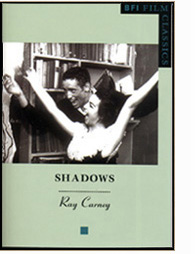
"Ray Carney is a tireless
researcher who probably knows more about the shooting of Shadows than
any other living being, including Cassavetes when he was alive, since
Carney, after all, has the added input of ten or more of the film’s
participants who remember their own unique versions of the reality
we all shared."—Maurice
McEndree, producer and editor of Shadows
"Bravo! Cassavetes
is fortunate to have such a diligent champion. I am absolutely dumbfounded
by the depth of your research into this film.... Your appendix...is
a definitive piece of scholarly detective work.... The Robert Aurthur
revelation is another bombshell and only leaves me wanting to know
more.... The book movingly captures the excitement and dynamic Cassavetes
discovered in filmmaking; and the perseverance and struggle of getting
it up there on the screen."—Tom
Charity, Film Editor, Time Out magazine
John Cassavetes’ Shadows is
generally regarded as the start of the independent feature movement
in America. Made for $40,000 with a nonprofessional cast and crew and
borrowed equipment, the film caused a sensation on its London release
in 1960.
The film traces the lives of
three siblings in an African-American family: Hugh, a struggling jazz
singer, attempting to obtain a job and hold onto his dignity; Ben, a Beat
drifter who goes from one fight and girlfriend to another; and Lelia,
who has a brief love affair with a white boy who turns on her when he
discovers her race. In a delicate, semi-comic drama of self-discovery,
the main characters are forced to explore who they are and what really
matters in their lives.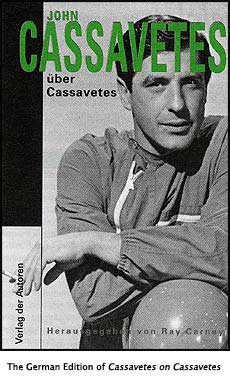
Shadows ends with the
title card "The film you have just seen was an improvisation," and
for decades was hailed as a masterpiece of spontaneity, but shortly
before Cassavetes’ death, he confessed to Ray Carney something
he had never before revealed – that much of the film was scripted.
He told him that it was shot twice and that the scenes in the second
version were written by him and Robert Alan Aurthur, a professional
Hollywood screenwriter. For Carney, it was Cassavetes‘ Rosebud.
He spent ten years tracking down the surviving members of the cast
and crew, and piecing together the true story of the making of the
film.
Carney takes the reader behind
the scenes to follow every step in the making of the movie – chronicling
the hopes and dreams, the struggles and frustrations, and the ultimate
triumph of the collaboration that resulted in one of the seminal masterworks
of American independent filmmaking.
Highlights of the presentation
are more than 30 illustrations (including the only existing photographs
of the dramatic workshop Cassavetes ran in the late fifties and of
the stage on which much of Shadows was shot, and a still showing
a scene from the "lost" first version of the film); and statements
by many of the film's actors and crew members detailing previously
unknown events during its creation.
One of the most interesting and original aspects of the book is a nine-page Appendix that "reconstructs" much of the lost first version of the film for the first time. The
Appendix points out more than 100 previously unrecognized differences
between the 1957 and 1959 shoots, all of which are identified in detail
both by the scene and the time at which they occur in the current print
of the movie (so that they may be easily located on videotape or DVD
by anyone viewing the film).
By comparing the two versions,
the Appendix allows the reader to eavesdrop on Cassavetes' process
of revision and watch his mind at work as he re-thought, re-shot, re-edited
his movie. None of this information, which Carney spent more than five
years compiling, has ever appeared in print before (and, as the presentation
reveals, the few studies that have attempted to deal with this issue
prior to this are proved to have been completely mistaken in their
assumptions). The comparison of the versions and the treatment of Cassavetes'
revisionary process is definitive and final, for all time.
This book is
available through University
of California Press at Berkeley, Amazon, Barnes
and Noble, and in England through Amazon (UK)
and The
British Film Institute. For a limited time, the Shadows book
is also available directly from the author (in discounted, specially
autographed editions) via this web site. See
information below on how to order this book directly from the author
by money order, check, or credit card (PayPal). 
Clicking on the
above links will open a new window in your browser. You may return
to this page by closing that window or by clicking on the window for
this page again.
For reviews and
critical responses to Ray Carney's book on the making of Shadows,
please click
here.
Ray Carney, American
Dreaming: The Films of John Cassavetes and the American Experience (Berkeley: University of California Press, 1985). $20.. $20.
[From the original
dust jacket description:] John Cassavetes is known to millions of filmgoers
as an actor who has appeared in Rosemary’s Baby, The
Dirty Dozen, Whose Life Is It, Anyway?, Tempest,
and many other Hollywood movies. But what is less known is that Cassavetes
acts in these films chiefly in order to finance his own unique independent
productions. Over the past 25 years, working almost entirely outside
the Hollywood establishment, Cassavetes has written, directed, and
produced ten extraordinary films. They range from romantic comedies
like Shadows and Minnie and Moskowitz to powerful,
poignant domestic dramas like Faces and A Woman Under
the Influence to unclassifiable emotional extravaganzas like Husbands, The 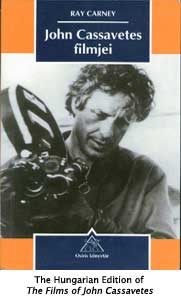 Killing
of a Chinese Bookie, and Gloria. Killing
of a Chinese Bookie, and Gloria.
This is the first
book-length study ever devoted to this controversial and iconoclastic
filmmaker. It is the argument of American Dreaming that Cassavetes
has single-handedly produced the most stunningly original and important
body of work in contemporary film. Raymond Carney examines Cassavetes’ life
and work in detail, traces his break with Hollywood, and analyzes the
cultural and bureaucratic forces that drove him to embark on his maverick
career. Cassavetes work is considered in the context of other twentieth-century
forms of traditional and avant-garde expression and is provocatively
contrasted with the better-known work of other American and European
filmmakers.
The portrait
of John Cassavetes that emerges in these pages is of an inspiringly
idealistic American dreamer attempting to beat the system and keep
alive his dream of personal freedom and individual expression – just
as the characters in the films excitingly try to keep alive their middle-class
dreams of love, freedom, and self-expression in the hostile emotional
and familial environments in which they function. His films are chronicles
of the yearnings, desires, and frustrations of the American dream.
He is America’s truest historian of the inevitable conflict between the ideals and the realities of the American experience.
"By
far the most thorough, ambitious, and far-reaching criticism of Cassavetes'
work has been accomplished by Raymond Carney, currently Professor of
Film and American Studies at Boston University. Carney wrote the first
book-length study of 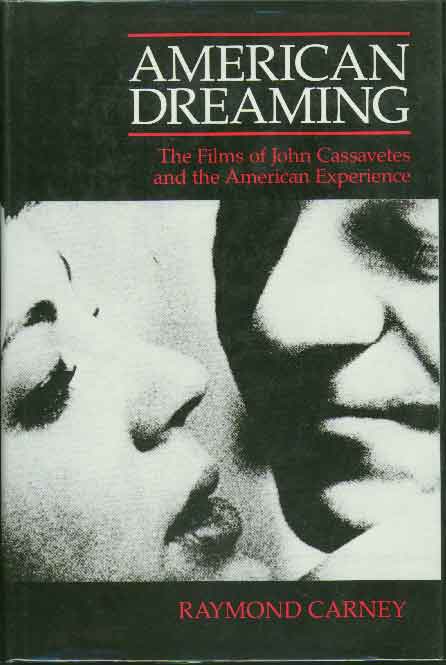 Cassavetes,
who languished in critical obscurity until the publication of Carney's American
Dreaming in 1985.... In Carney's view, to settle the accounts
of our lives, to decide once and for all, is, for Cassavetes, to tumble
headlong into the abyss of nonentity upon which we incessantly verge.
Carney argues that Cassavetes has re-invented the craft of filmmaking
in ways that drastically alter our casual habits of film viewing. To
adapt William James' terminology (which Carney is indebted to) Cassavetes'
works are concerned less with the events and finished episodes that
make up the 'substantive' parts of our experience and more
with the moments of insecurity, the 'transitive' slippages
during which our habitual strategies for understanding and stabilizing
our relationships with ourselves and others cease to function in any
useful way.... Carney's work with Cassavetes, placed within the context
of his later book, American Vision, on Frank Capra, can be
viewed as an attempt not only to further the understanding of American
film, but to forge a new synthesis of understanding in American Studies,
making his critical works valuable not only to film scholars, but to
students of American culture generally." — Lucio
Benedetto, PostScript Magazine Cassavetes,
who languished in critical obscurity until the publication of Carney's American
Dreaming in 1985.... In Carney's view, to settle the accounts
of our lives, to decide once and for all, is, for Cassavetes, to tumble
headlong into the abyss of nonentity upon which we incessantly verge.
Carney argues that Cassavetes has re-invented the craft of filmmaking
in ways that drastically alter our casual habits of film viewing. To
adapt William James' terminology (which Carney is indebted to) Cassavetes'
works are concerned less with the events and finished episodes that
make up the 'substantive' parts of our experience and more
with the moments of insecurity, the 'transitive' slippages
during which our habitual strategies for understanding and stabilizing
our relationships with ourselves and others cease to function in any
useful way.... Carney's work with Cassavetes, placed within the context
of his later book, American Vision, on Frank Capra, can be
viewed as an attempt not only to further the understanding of American
film, but to forge a new synthesis of understanding in American Studies,
making his critical works valuable not only to film scholars, but to
students of American culture generally." — Lucio
Benedetto, PostScript Magazine
American
Dreaming: The Films of John Cassavetes and the American Experience (Berkeley, California: University of California Press,
1985), the first book ever written about Cassavetes' life and work, in
any language. It has long been out of print but is now newly available
through this web site for $20 in a Xerox of the original edition. You
may order with a credit card through PayPal or through the mail with
a money order. See below.
* * *
In addition,
two packets of Ray Carney's writings on John Cassavetes (material
not included in any of the above books) are also specially available
through this web site. These packets contain the texts of many of
his notes and essays about the filmmaker. Each packet is available
for $15.00.
Collected
Essays on the Life and Work of John Cassavetes (a packet of
essays by Ray Carney previously published in magazines, newspapers,
and periodicals and now unavailable). Approximately 130 pages. A loose-leaf
bound packet of Ray Carney's writings on John Cassavetes is specially
available only through this web site. The packet has the complete texts
of program notes and essays about Cassavetes that were published by
Ray Carney in a variety of film journals and general interest periodicals
between 1989 and the present. It contains more than fifteen separate
pieces – including the keynote essay commissioned by the Sundance
Film Festival for their retrospective of Cassavetes' work at the time
of his death as well as the memorial piece on Cassavetes awarded a
prize by The Kenyon Review as "one of the best essays of the
year by a younger author."
This packet also
contains the text Ray Carney contributed to the "Special John
Cassavetes Issue" of PostScript edited
by Ray Carney, including "A Polemical Introduction: The Road Not
Taken," "Seven Program Notes from the American Tour of the
Complete Films: Faces, Minnie and Moskowitz, Woman
Under the Influence,
The Killing of a Chinese Bookie, and Love Streams."
The Collected Essays on
the Life and Work of John Cassavetes is not for sale in any store,
and available exclusively on this web site for $15.00 under the same credit
payment terms or at the same mailing address as the other offers. 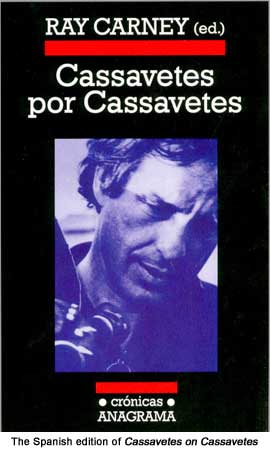
***
"Special
Issue: John Cassavetes." PostScript: Essays in Film and
the Humanities Vol. 11 Number 2 (Winter 1992). Guest editor:
Ray Carney $10.
Handsomely illustrated.
113 double-column pages (50,000 words).
A memorial tribute
to the life and work of John Cassavetes. Essays by Ray Carney, George
Kouvaros, Janice Zwierzynski, and Carole Zucker. Interviews with Al
Ruban and Seymour Cassel by Maria Viera. A history of the critical
appreciation of Cassavetes' work and a bibliography of writing in English
by Lucio Benedetto. The issue is illustrated with more than 40 behind-the-scenes
photos of Cassavetes and his actors and contains many personal statements
by him about his life and work.
This issue includes
eight essays by Ray Carney about Cassavetes' life and work: "A
Polemical Introduction: The Road Not Taken," and "Seven Program
Notes from the American Tour of the Complete Films, about Faces, Minnie
and Moskowitz, Woman Under the Influence, The Killing
of a Chinese Bookie, and Love Streams." But note
that Ray Carney's contributions to the special Cassavetes issue of PostScript magazine
are also available as part of the packet, The Collected Essays
on the Life and Work of John Cassavetes, which contains many other
pieces by Prof. Carney as well. The Collected Essays packet is listed separately above at a price of $15. But if you would like a Xerox copy
of the entire PostScript magazine issue (which includes the
other additional material by the other authors listed above), the PostScript issue
is available separately for $10. You may order it with a credit card
through PayPal or through the mail with a money order. See the instructions
below.
***
In addition,
a packet comparing the two versions of Shadows is available: A
Detective Story – Going Inside the Heart and Mind of the Artist:
A Study of Cassavetes' Revisionary Process in the Two Versions of
Shadows.
Available direct from the author through this site for $15.
This packet contains the following
material (most of which was not included in the BFI Shadows book):
- An introductory essay about
the two versions of the film
- A table noting the minute-by-minute,
shot-by-shot differences in the two prints. (In the British Film
Institute book on Shadows, this table appears in a highly
abridged, edited version, at less than half the length and detail
presented here.)
- A conjectural reconstruction
of the shot sequence in the 1957 print
- A shot list for the 1959
re-shoot of the film
- The credits exactly as
presented in the film (including typographical and orthographical
vagaries indicating Cassavetes' view of the importance of various
contributors)
- An expanded and corrected credit listing that includes previous uncredited actors and appearances (e.g. Cassavetes in a dancing sequence; Gena Rowlands in a chorus girl sequence; and Danny Simon and Gene Shepherd in the nightclub sequence)
- Notes about the running
times of both versions and information about dates and places of
early screenings
- A bibliography of suggested
additional reading (including a note about serious mistakes in previous
treatments of the film by other authors)
Very little
of this material was included in the BFI book on Shadows due
to limitations on space. This 85-page (25,000 word) packet is not for
sale in any store and is available exclusively through this site for
$15.
***
The five books, two packets,
and issue of PostScript magazine may be obtained directly from the author, by using the Pay
Pal Credit Card button below, or by sending a check or money order
to the address below. However you order the book or books, please provide
the following information:
- Your name and address
- The title of the book you
are ordering
- Whether you would like
an inscription or autograph on the inside front cover
Checks or money orders may
be mailed to:
Ray Carney
Special Book Offer
College of Communication
640 Commonwealth Avenue
Boston University
Boston, MA 02215
|

|
Credit
Card
|
| NEW! |
| Now
you can buy Ray Carney's works online using Visa or MasterCard. |
|
Note:
If you pay by credit card using the PayPal button, please note in the
item description or comments section of the order form the exact
title of the item or items you are ordering (be specific, since many
items have similar titles), as well as any preferences you may have
about an autograph or inscription and the name or nickname you would
like to have on the inscription.
If you are confused
by the PayPal form, or unsure where to enter this information,
you may simply make your credit card payment that way, and separately
email me (at the address below) any and all information about
what item you are ordering, and what inscription or name you
would like me to write on it, or any other details about your
purchase. I will respond promptly.
The PayPal form has
a place for you to indicate the number of items you want (if
you want more than one of any item), as well as your mailing
address.
If you place your order
and send your payment by mail, please include a sheet of paper
with the same information on it. I am glad to do custom inscriptions
to friends or relatives, as long as you provide all necessary
information, either on the PayPal form, in a separate email to
me, or by regular mail. (Though I cannot take credit card information
by mail; PayPal is the only way I can do that.)
If you want to order
other items from other pages, and are using the PayPal button,
you may combine several items in one order and have your total
payment reflect the total amount, or you may order other items
separately when you visit other pages. Since there is no added
shipping or handling charge (shipping in the US is free), you
will not be penalized for ordering individual items separately
in separate orders. It will cost exactly the same either way.
These instructions
apply to American shipments only. Individuals from outside the
United States should email me and inquire about pricing and shipping
costs for international shipments.
Clicking on PayPal
opens a separate window in your browser so that this window and
the information in it will always be available for you to consult
before, during, and after clicking on the PayPal button. After
you have completed your PayPal purchase and your order has been
placed, you will automatically be returned to this page. If,
on the other hand, you go to the PayPal page and decide not to
complete your order, you may simply close the PayPal window at
any point and this page should still be visible in a window underneath
it.
If you have questions,
comments, or problems, or if you would like to send me additional
information about your order, please feel free to email me at: raycarney@usa.net.
(Note: Due to the extremely high volume of my email correspondence,
thousands of emails a week, and the diabolical ingenuity of Spammers,
be sure to use a distinctive subject heading in anything you send
me. Do NOT make your subject line read "hi" or "thanks"
or "for your information" or anything else that might
appear to be Spam or your message will never reach me. Use the name
of a filmmaker or the name of a familiar film or something equally
distinctive as your subject line. That is the only way I will know
that your message was not automatically generated by a Spam robot.)
Problems? Unable to access
the PayPal site? If you are having difficulty, it is generally because
you are using an outdated or insecure browser. Click
here for help and information about how to check your browser's
security level or update it if necessary.
|
|










